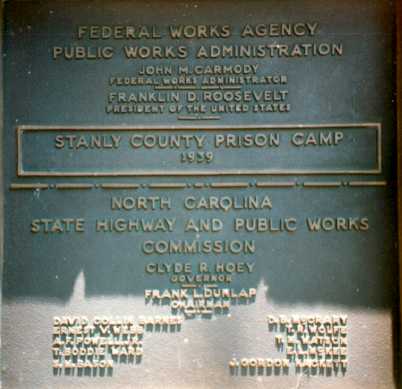As early as 1875, private employers could lease inmates as laborers. Under the lease, businesses had complete responsibility for the inmates. Many worked in rock quarries and built railways. In 1901, lawmakers changed the system to provide for contract inmate labor. Inmates worked for private employers, but prison officials retained responsibility for the inmates' custody.
In 1901, the Good Roads Policy provided inmate labor to build the state's roads. Horse-drawn prison cages that moved from one worksite to the next housed the inmates. In 1910, the incentive wage system began and inmates earned up to 15 cents a day, paid upon release.
In 1925, the General Assembly enacted a law changing the state's prison from a corporation to a department of state government. At that time, the state prison system included Central Prison, Caledonia Prison Farm, Camp Polk Prison Farm and eight road camps. Over the next eight years, six more road camps were added. By then, the facilities at these units were in deplorable condition for lack of regular maintenance and repair.
 In 1931, the General Assembly enacted the Conner bill which
enabled the state to take over control of all prisons and
inmates. The condition of prison facilities and the need for
inmate labor led the General Assembly to consolidate the State
Highway Commission and the State Prison Department. This provided
new construction money from the Highway Fund for prison
renovation.
In 1931, the General Assembly enacted the Conner bill which
enabled the state to take over control of all prisons and
inmates. The condition of prison facilities and the need for
inmate labor led the General Assembly to consolidate the State
Highway Commission and the State Prison Department. This provided
new construction money from the Highway Fund for prison
renovation.
In the two years before consolidation, the State Highway Commission spent $850,000 for permanent improvements in the road camps that had been operated by the counties. With the help of WPA labor, the renovation and construction program continued after consolidation of the two agencies. In 1933, a $400,000 bond issue provided for establishing and equipping additional prison camps, farms and industries. Lawmakers authorized the State Highway and Public Works Commission to purchase, lease and erect buildings at new road camp sites. These permanent road camps were of a standard design and small capacity. The basic design was for 100 inmates. Camps were located throughout the state, primarily for the convenience of road building and repair.
About 1930, prison
industries began. At a plant near Central Prison, inmates made
concrete pipe for the state highway commission. The plant
operated until federal highway funding restrictions put an end to
the use of inmate labor for such operations in 1936. Over the
years, other prison industries developed to meet prison needs,
like farming operations to provide food and tailoring operations
to provide clothing.
In 1935, women inmates from Central Prison moved to a south Raleigh prison camp, the site of today's Correctional Institution for Women. Women from the Caledonia Prison Farm moved to the Raleigh facility permanently in 1956.
In 1957, the General Assembly separated the state prison department from the State Highway and Public Works Commission. As part of this change, the Council of State recommended consolidation of prison operations that resulted in the closing of prisons in Ashe, Beaufort, Brunswick, Chatham, Cherokee, Craven, Edgecombe, Hertford, Jackson, Macon, Perquimans, Pitt, Surry, Transylvania and Wilson counties. The prison properties were reassigned to other state and local governments or sold, except for two units that continued to be used by the Division of Prisons. The Pitt county facility became the Eastern Area Office and the Surry county facility became the Dobson training center.
In 1957, North Carolina became the first state to initiate a work release program that allowed inmates to work in private employment during the day and return to confinement at night.In 1958, striped prison
clothing was replaced with gray uniforms for close
custody, brown for medium and green for minimum. In
1965, all prisons were desegregated.
In 1965, mental health services were established in prisons. The first mental health wards for inmates were built in 1973 at Central Prison. Mental Health Services established its first sex offender treatment program at Harnett Correctional Institution in 1991.
Correction staff, state and local police killed six inmates and wounded 68 others in quelling a riot at Central Prison in April 1968. Two state troopers and two correction officers were injured by ricocheting shot as prison officials regained control of the prison in the early hours of April 17.
In 1970, correction custody staff's job title changed to correctional officer from guard or matron. In 1974, the state Criminal Justice Academy was founded and began certification training for correction staff.
The Government Reorganization Act of 1973 created the Department of Social Rehabilitation and Control which included prisons, probation and parole and juvenile facilities.
In 1974, the agency was renamed the Department of Correction with two major subdivisions, the Division of Prisons and the Division of Adult Probation and Parole. In 1975, lawmakers transferred the Division of Youth Development and the responsibility of managing the state's training schools from the Department of Correction to the Department of Human Resources.
In the early 1970s, the state prison system increased prison capacity for male youth constructing Western Youth Institution which opened in 1972 and converting state facilities into the Sandhills Youth Center in 1973; Fountain Youth Center in 1976; and Morrison Youth Institution in 1977. In 1978, state prison capacity increased by 822 with the addition of a number of modular housing units, mainly at minimum security prisons.
In the 1980s major renovations were completed at Central Prison. A new administration building, maximum security building and workers residence building provided 500 cells replacing cellblocks in the old castle-like structure which was torn down. Three more prisons were constructed: Piedmont Correctional Institution which opened in 1979; Eastern Correctional Institution which opened in 1983; and Southern Correctional Institution which opened in 1983. Other state facilities were converted into the Wayne Correctional Center in 1979 and McCain Correctional Hospital in 1983.
In 1987, lawmakers established the department's division for substance abuse treatment and the first Drug/Alcohol Recovery Treatment program at Wayne Correctional Center. The state's first boot camp program for male youth opened in Richmond County in October 1989.
In the 1980s, a series of lawsuits filed by inmates complained about conditions in state prisons, mainly minimum and medium security units built in the late 1930's. Small v Martin, filed in 1985, affected 49 of these prisons. During this same time, annual prison admissions nearly doubled from 17,500 in 1986 to 30,800 in 1992.
 In response, the General Assembly capped the prison
population, initiated a study of state sentencing laws, provided
for increased community supervision and launched a major prison
construction program. Lawmakers provided for $185 million in
prison construction between 1985 and 1990. Voters gave their
approval to a $200 million prison construction bond issue in
1990. Lawmakers approved another $62 million for prison
construction in 1994.
In response, the General Assembly capped the prison
population, initiated a study of state sentencing laws, provided
for increased community supervision and launched a major prison
construction program. Lawmakers provided for $185 million in
prison construction between 1985 and 1990. Voters gave their
approval to a $200 million prison construction bond issue in
1990. Lawmakers approved another $62 million for prison
construction in 1994.
Gov. Hunt and Correction Secretary Franklin Freeman pushed the prison population from 20,351 at the end of 1992 to 30,775 at the end of 1996. They sped up planned construction, pushed through legislation for additional construction and leased space in county jails and out-of-state prisons to immediately meet the state's needs and bring an end to the policy of using early parole to free up prison space. Paroles decreased from a high of 26,784 in 1993 to 12,461 in 1996.
Four new close security prisons opened in the early 1990s including Nash Correctional Institution in 1993; Foothills Correctional Institution in 1994; Marion Correctional Institution in 1995; and Pasquotank Correctional Institution in 1996.
Three new medium security prisons opened in the early 1990s including Brown Creek Correctional Institution in 1993 and Pender and Lumberton correctional institutions in 1994. A new minimum security prison, Neuse Correctional Institution opened in 1994.
The IMPACT boot camp program quadrupled in size with the opening of a new dorm at IMPACT East and the opening of IMPACT West in 1994. A second dorm opened at IMPACT West in 1995. The IMPACT program ended by legislative order in August 2002.
In 1993, the General Assembly enacted Structured Sentencing. It went into effect for crimes committed after October 1, 1994. The new criminal sentencing law replaced the Fair Sentencing statutes.
In 1994, the General Assembly provided for expansion of prison substance abuse treatment programs and created the community service work program, to provide local governments with minimum custody inmates under the supervision of correction staff for short-term work projects. Lawmakers also allowed the department to contract for private substance abuse treatment of minimum security inmates and contract for housing state prisoners in out-of-state facilities and NC county jails.
Under legislative direction, the department closed Richmond and Moore correctional centers in 1995. Earlier condition of confinement lawsuits had increased staffing requirements while reducing the number of inmates allowed at several of these 1930s-era prisons reducing the efficiency of operations.
On February 20, 1997, U.S. District Judge Earl Britt issued a court order ending federal court jurisdiction over state prisons.
In 1997, six new prisons opened adding 2,984 beds to the system capacity. The new prisons included the medium security Craven Correctional Institution at Vanceboro, medium security Hyde Correctional Center at Swan Quarter, minimum security Dan River Prison Work Farm at Yanceyville, medium security Warren Correctional Institution at Warrenton, minimum security North Piedmont Correctional Center for Women at Lexington and close security Polk Youth Institution at Butner.Dan River's housing unit was the first major inmate construction project undertaken since inmate labor was used to build Central Prison in the 1890s. Opening the new Polk at Butner allowed the department to close the old Polk prison on Blue Ridge Road in Raleigh.
In 1998, the minimum security Tyrrell Prison Work Farm opened. DOC Engineering directed inmate crews in the construction of this prison, similar to Dan River. Opening Tyrrell allowed the department to close Washington Correctional Center.
In the legislative session that ended in October 1998, the General Assembly ordered the closing of Alexander, Martin, Mecklenburg and Sandy Ridge correctional centers and eliminated lethal gas as a method of execution.
In 1999, prison consolidation continued with the closing of 11 facilities. Stanly, Yancey, Currituck and Goldsboro Correctional Centers closed in July and August. Blanch Youth Institution and Yadkin, Nash and Watauga Correctional Centers were closed in September. In October, Stokes, Avery and Iredell Correctional Centers closed. The new 624-bed medium security facility Avery-Mitchell Correctional Institution in Spruce Pine was dedicated on Oct. 14. On Nov. 9, another new prison opened in the state's south-central region with the dedication of Albemarle Correctional Institution.
On October 1, 2000, North Carolina's two year experiment with privately-run prisons came to an end as the Department of Correction assumed control of Pamlico Correctional Institution in Bayboro and Mountain View Correctional Institution in Spruce Pine. Both facilities were opened by Corrections Corporation of America in 1998. Two years after assuming operations, the state purchased the two prison facilities.
On January 1, 2012, the Department of Correction consolidated with the Department of Crime Control and Public Safety and the Department of Juvenile Justice and Delinquency Prevention to form the new North Carolina Department of Public Safety. Reuben Young was named the new secretary of the consolidated agency.